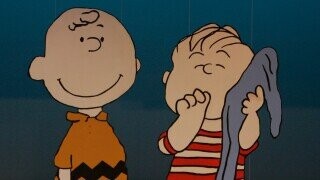15 Blockheaded Trivia Tidbits About Charlie Brown's Peanuts

If you think it’s weird that Homer Simpson has belonged to at least three different generations over the course of his show’s run, consider the Peanuts, who remained children for a full 50 years. In that length of time, things were bound to get weird, especially under the iron fist of creator and sole cartoonist Charles Schulz, who was half unproblematic fave, half madman.
Why It’s Called Peanuts

If you’ve ever wondered why it’s called Peanuts when nobody in the strip ever calls each other a peanut or mentions peanuts or even enjoys a salty snack, it was originally called Li’l Folks when Schulz wrote it for the St. Paul Pioneer Press. When Schulz submitted it to United Features Syndicate, however, he was informed that a comic by that name already existed, and they selected Peanuts as an alternative, inspired by the all-kid “peanut gallery” on Howdy Doody. Schulz never liked the name, feeling it didn’t have the “dignity” deserving of a boy who keeps falling on his ass after failing to kick a football.
Why There’s No Adults

(Warner Bros.)
Schulz liked to say that adults never appear in the strip because it’s “only an inch and a half high, and they wouldn’t have room to stand up,” but he clarified that “actually, they have been left out because they would intrude in a world where they could only be uncomfortable.” Which doesn’t really clarify anything. Permanent crouching is definitely uncomfortable.
The Wah-Wah Voice

Adults did eventually have to make faceless appearances for the TV specials and movies, so producer Lee Mendelson asked Vince Guaraldi, the jazz composer who wrote the Peanuts’ instantly recognizable songs, “if there were some instrument that could sound like talking.” He whipped out a trombone, and a classic sound effect was born. It’s not clear why they couldn’t just talk offscreen, but we don’t have the wildly successful franchise.
The Little Red-Haired Girl Was Real
Charlie Brown pined over the Little Red-Haired Girl for 50 years, and so did Charles Schulz. She was based on a redheaded woman he was dating when he created the comic who left him for another man. Even though he eventually married twice, he admitted that he never got over her and said as late as 1989 that his life would have been “perfect” if she’d stayed. Little sketch, Charlie.
Linus Invented Security Blankets

(Warner Bros.)
“Security blankets,” in the sense of a blankie one (usually a baby, but no judgment) carries around for comfort, weren’t really a thing until Linus made it a thing. The term had been in use in other contexts, most hilariously in the military, so Schulz was likely familiar with it, but he told the Oxford English Dictionary that he thought “it was the readers who eventually coined the phrase.”
“Blockhead” is an Old, Old Insult

If you call someone a blockhead now, they’ll probably be like “Okay, Pig-Pen,” but the insult goes back to the 1500s, when it referred to blocks used by hatmakers. Schulz liked it because he thought words that start with B are inherently funnier.
Both Peppermint Patties Were Named Independently

You might have assumed your grandma’s favorite candy bar was named after the Peanuts character or vice versa, because it would be completely ridiculous for two people to come up with that name on their own, but it appears to be what happened. When Schulz named the character, York was still a small company whose distribution was limited to its native Pennsylvania, pretty far from Schulz’s Minnesota. For his part, Schulz said he named the character after his cousin and a dish of peppermint candies, confirming everything we suspect about professional character naming.
Woodstock Before Woodstock

Meanwhile, Woodstock actually existed in the strip for several years before the music festival that gave him his name. No, Schulz wasn’t psychic (as far as we know) -- the little yellow bird just didn’t have a name until Schulz threw it in there for “people who like that sort of thing.” Yep, Peanuts pandered to stoners.
Schulz Murdered a Character
In 1954, Schulz introduced a character named Charlotte Braun who proved to be unpopular and eventually killed her off in a letter to a fan who was clearly in over their head. In response to the fan, who evidently complained about the character, Schulz responded, “I am taking your suggestion regarding Charlotte Braun and will eventually discard her. Remember, however, that you and your friends will have the death of an innocent child on your conscience. Are you prepared to accept such responsibility?” Then he drew Charlotte with an ax through her head, suggesting a world in which Peanuts true crime exists.
The First Half-Hour Christmas Special
Before A Charlie Brown Christmas, animated holiday specials were traditionally an hour long, but director Bill Melendez -- having been commissioned by Coca-Cola on short notice -- said there just wasn’t enough time to draw that much. When you knock out How the Grinch Stole Christmas and Frosty the Snowman in a tight 60 this year, thank him.
Charles Schulz, the War on Christmas Soldier
In the day before the Veggie Tales, mixing religion and television, even on Christmas, was a big no-no. Still, Schulz insisted that A Charlie Brown Christmas would be about “the true meaning of Christmas” and feature Bible verses, to the point that “we wouldn’t have done the show” if it hadn’t been allowed.
Charlie Brown Killed the Aluminum Christmas Tree

An aluminum Christmas tree sounds like something that would be built in a frat house over a boring winter break, but they were all the rage in the early ‘60s. After A Charlie Brown Christmas portrayed them as a symptom of the “modern” commercialism antithetical to the “true meaning of Christmas,” though, sales dropped until the industry disappeared entirely within five years, and Christmas trees have been tasteful and pious ever since.
Snoopy in Vietnam
Snoopy may have only ever played pretend war, but the nuanced views on the Vietnam War expressed in the strip made the doggie dog “a significant, if underappreciated, part of Americans’ Vietnam War iconography.” He appeared on soldiers’ helmets and patches, and one squadron even wrote to Schulz to ask permission to use him as their official mascot. It was a more intellectual property–respectful time.
Snoopy in Space

Snoopy also serves as NASA’s personal safety mascot. It all goes back to Apollo 10, whose lunar module was named after the most famous beagle because its mission was to “snoop” on the future moon landing site. NASA also named the command module after Charlie Brown, mostly because they just had a bit now.
Thanksgiving Cannibalism

(Warner Bros.)
At the end of A Charlie Brown Thanksgiving, Woodstock can be seen eating turkey, which has horrified viewers for the last half-century. This was no oversight -- Mendelson told the Washington Post he “always objected to Woodstock eating the turkey,” but he was overruled. These days, the scene is often deleted on rebroadcast, but prepare yourself for the annual tsunami of tweets from people who just realized something is terribly wrong on their uncle’s old VHS.
Top image: Otterbein University Theatre & Dance/Wikimedia Commons